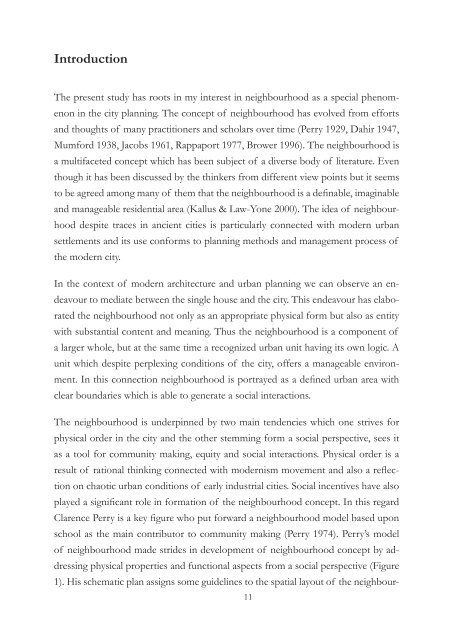Accessibility and Street Layout Exploring spatial equity in
Accessibility and Street Layout Exploring spatial equity in
Accessibility and Street Layout Exploring spatial equity in
You also want an ePaper? Increase the reach of your titles
YUMPU automatically turns print PDFs into web optimized ePapers that Google loves.
Introduction<br />
The present study has roots <strong>in</strong> my <strong>in</strong>terest <strong>in</strong> neighbourhood as a special phenomenon<br />
<strong>in</strong> the city plann<strong>in</strong>g. The concept of neighbourhood has evolved from efforts<br />
<strong>and</strong> thoughts of many practitioners <strong>and</strong> scholars over time (Perry 1929, Dahir 1947,<br />
Mumford 1938, Jacobs 1961, Rappaport 1977, Brower 1996). The neighbourhood is<br />
a multifaceted concept which has been subject of a diverse body of literature. Even<br />
though it has been discussed by the th<strong>in</strong>kers from different view po<strong>in</strong>ts but it seems<br />
to be agreed among many of them that the neighbourhood is a def<strong>in</strong>able, imag<strong>in</strong>able<br />
<strong>and</strong> manageable residential area (Kallus & Law-Yone 2000). The idea of neighbourhood<br />
despite traces <strong>in</strong> ancient cities is particularly connected with modern urban<br />
settlements <strong>and</strong> its use conforms to plann<strong>in</strong>g methods <strong>and</strong> management process of<br />
the modern city.<br />
In the context of modern architecture <strong>and</strong> urban plann<strong>in</strong>g we can observe an endeavour<br />
to mediate between the s<strong>in</strong>gle house <strong>and</strong> the city. This endeavour has elaborated<br />
the neighbourhood not only as an appropriate physical form but also as entity<br />
with substantial content <strong>and</strong> mean<strong>in</strong>g. Thus the neighbourhood is a component of<br />
a larger whole, but at the same time a recognized urban unit hav<strong>in</strong>g its own logic. A<br />
unit which despite perplex<strong>in</strong>g conditions of the city, offers a manageable environment.<br />
In this connection neighbourhood is portrayed as a def<strong>in</strong>ed urban area with<br />
clear boundaries which is able to generate a social <strong>in</strong>teractions.<br />
The neighbourhood is underp<strong>in</strong>ned by two ma<strong>in</strong> tendencies which one strives for<br />
physical order <strong>in</strong> the city <strong>and</strong> the other stemm<strong>in</strong>g form a social perspective, sees it<br />
as a tool for community mak<strong>in</strong>g, <strong>equity</strong> <strong>and</strong> social <strong>in</strong>teractions. Physical order is a<br />
result of rational th<strong>in</strong>k<strong>in</strong>g connected with modernism movement <strong>and</strong> also a reflection<br />
on chaotic urban conditions of early <strong>in</strong>dustrial cities. Social <strong>in</strong>centives have also<br />
played a significant role <strong>in</strong> formation of the neighbourhood concept. In this regard<br />
Clarence Perry is a key figure who put forward a neighbourhood model based upon<br />
school as the ma<strong>in</strong> contributor to community mak<strong>in</strong>g (Perry 1974). Perry’s model<br />
of neighbourhood made strides <strong>in</strong> development of neighbourhood concept by address<strong>in</strong>g<br />
physical properties <strong>and</strong> functional aspects from a social perspective (Figure<br />
1). His schematic plan assigns some guidel<strong>in</strong>es to the <strong>spatial</strong> layout of the neighbour-<br />
11

















